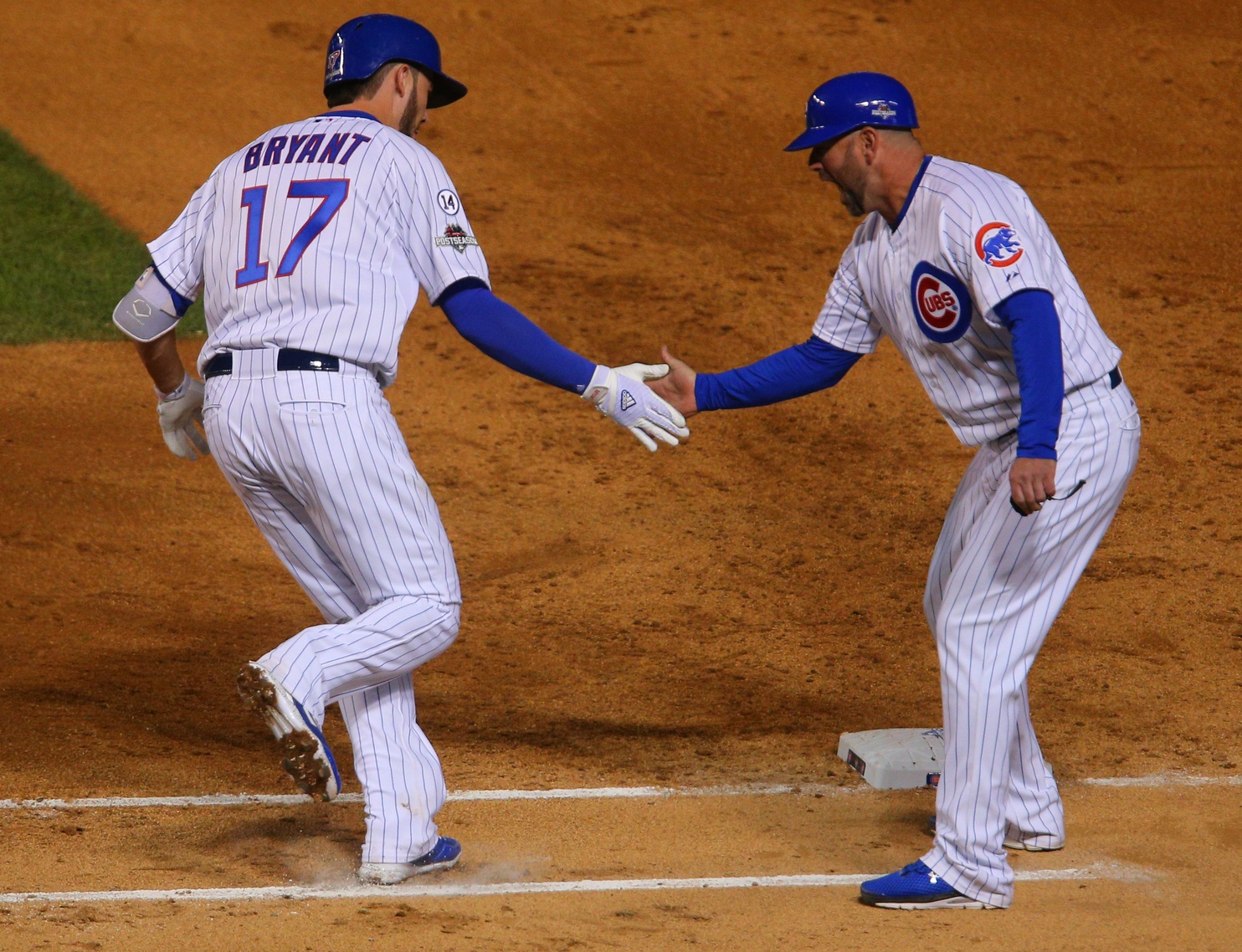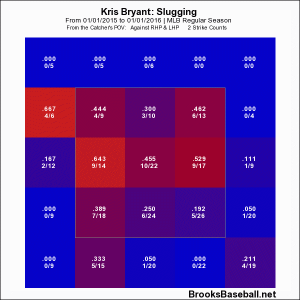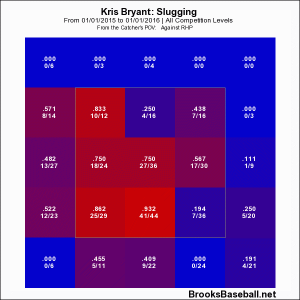Call out the instigator
Because there’s something in the air
As Kris Bryant’s go-ahead home run sailed into the North Side evening air, one could not help but wonder what Michael Wacha and Yadier Molina had been thinking in throwing him a sixth straight four-seam fastball. This season, Bryant slugged .490 and hit seven home runs on four-seam fastballs from right-handed pitchers. Wacha’s four-seam fastball against right-handed batters had been devastating through August (.373 SLG and four home runs), but it was atrocious in September (.568 and three home runs).
During the regular season, Bryant went 3-for-10 with a walk and home run against Wacha, with the home run coming on September 19th at Wrigley Field. In that September at-bat, Wacha started Bryant with a cutter way off the plate for ball one, and then got Bryant to chase and foul off a 95-mph four-seam fastball up and slightly off the plate. With the count even, Wacha came over the plate with an 85.6-mph change:
Bryant hammered the pitch into the left-field bleachers. Would this scare off Wacha and Molina from going back to the change on Monday?
Wacha started Bryant with a 94-mph four-seam fastball off the outside corner for ball one. This season, Wacha went to his fastball 60 percent of first pitches. On 1-0, Wacha went back to the same spot, just slightly elevated, with a 93-mph four-seam fastball for ball two. Behind in the count, Wacha went to the same spot on the outside corner, this time low, with a 93-mph four-seam fastball for ball three.
When behind right-handed batters this season, Wacha went to his four-seam fastball 63 percent of the time. Bryant had 22 3-o counts this season, and he swung at just four pitches in the situation, putting just just one ball in play, and not recording any hits. Even though Bryant had done nothing in 3-0 counts , the high likelihood of the four-seam fastball from a pitcher struggling with the pitch meant he had the green light.
Bryant swung through a belt-high 96-mph four-seamer, with Wacha reaching back for a bit extra. On 3-1, he stayed in the zone with a 94-mph four-seam fastball, but a bit lower, and Bryant fouled off the pitch. At this point, the TBS broadcasters noted that Bryant appeared late on the fastballs. The count was now full.
Just an inning earlier, Wacha had went his curve against Starlin Castro, and Castro had crushed a game-tying home run. Would he dare deviate from his fastball again in a crucial situation, or would he become even more dependent and go to a sixth straight four-seam against Bryant?
First, how did Bryant and Wacha perform this season once the count reached 3-2?
Bryant on 3-and-2 this season…
.203/.508/.367, 3 HR, 38.3 percent walk rate, 28.1 percent strikeout rate
Not surprisingly for a player with 199 strikeouts, with two strikes this season, Bryant hit just .151/.272/.256. Despite these two strikes issues, however, Bryant was still effective when pitchers came up in the strike zone:
With two strikes, Bryant is able to cover the entire plate on pitches up in the strike zone. Pitchers need to stay down and away from Bryant when they get to two strikes.
Against four-seam fastballs in full counts this season, Bryant hit .138 and slugged .276 with one home run, meaning that despite Wacha’s well-documented struggles with his go-to pitch, it seemed like a good bet he could go with his strength against a Bryant weakness. Wacha would just need to make sure he kept it low and on the outer edge of the plate.
Wacha on 3-and-2 this season…
.294/.560/.569, 2 HR, 36.9 percent walk rate, 14.3 percent strikeout rate
Predictably, Wacha went to his four-seam fastball 65 percent of the time in full counts, and 72 percent against right-handed batters, who slugged .563 with a home run and 13 walks. While Wacha’s four-seam fastball was an overall nightmare in September, with two strikes, he used it to record 10 of 19 strikeouts, and held batters to a .346 slugging percentage. His primary pitch has become a liability down the stretch, but it was still effective with two strikes.
When Wacha went to his change, curve, and cutter in full counts against right-handed batters, he did not surrender an extra-base hit. With Wacha in a massive funk, would they go away from the pitch with which he is most comfortable?
The Pitch…
With the count full, Molina set up low and on the outside corner, but Wacha’s four-seam fastball ran belt high and back over the heart of the plate. Bryant launched the ball into the left-field bleachers, and the Cubs grabbed a 4-2 lead.
The intended pitch location was smart, as not only does Bryant struggle with two strike pitches low and away, but he does little against right-handed pitchers when they go low and away:
Instead, Wacha gave Bryant his third chance on a four-seam fastball up and over the heart of the plate, areas of the strike zone where Bryant is comfortable with two strikes and destroys right-handers.
Had this matchup occurred a month earlier, Wacha might have been more likely to go to his cutter, curve, or change, which he throws a combined 41 percent of time to right-handed batters. On this night, though, he had struggled to locate his cutter, and he already surrendered a home run on the curve to a right-handed batter. This season, Bryant slugged .303 against changeups from right-handed pitchers, and entering September, Wacha held opposing righties to a .295 slugging percentage with the pitch. In September, though, right-handed batter slugged 1.125 against Wacha’s change. He surrendered two home runs on the pitch, including the one to Bryant in mid-September.
Wacha’s four-seam fastball is a mess right now, except with two strikes, and with his overall struggles recently, Bryant’s September home run on the change, and Castro’s earlier home run on the curve, Wacha and Molina stayed with his primary pitch. Bryant made him pay.
Lead photo courtesy of Dennis Wierzbicki-USA TODAY Sports




From what I saw of Bryant’s abs in minors and in the spring a high pct of his homers were hit to right. It seemed that many pitches were away and lower half. Has he changed his zone this season?